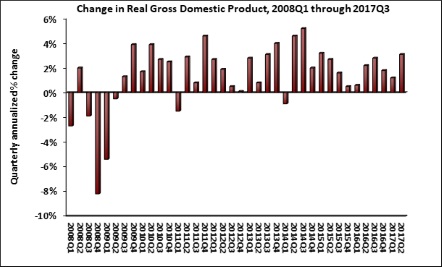Construction Industry Benefits From Consecutive Quarterly GDP Gains, Says ABC
WASHINGTON, Oct. 27—The U.S. economy expanded at an annual rate of 3 percent during the third quarter of 2017, according to Associated Builders and Contractors’ analysis of gross domestic product (GDP) data released today by the Bureau of Economic Analysis. Nonresidential fixed investment, a category of GDP associated with nonresidential construction activity, also contributed to growth as it expanded at an annual rate of 3.9 percent.
The third quarter’s overall performance follows a second quarter during which the economy expanded at roughly the same annual rate (3.1 percent). The back-to-back expansion represents the largest gains in two consecutive quarters registered since 2014. A 2.4 percent increase in consumer spending buoyed third quarter growth, while nonresidential fixed investment’s growth primarily was driven by investment in equipment and intellectual property, as opposed to structures. It also likely was boosted by the major hurricanes that hit parts of the United States during the quarter, which served to increase inventory accumulation. Inventory accumulation added 0.7 percentage points to growth during the quarter.
“Construction firms are among the major beneficiaries of the most recent GDP report, which confirms that the U.S. economy enjoys a level of momentum not observed for several years,” said ABC Chief Economist Anirban Basu. “Given the stupendous rise in asset values in recent years, including commercial real estate values, many economic actors have become concerned that real estate values could stagnate or decline. That would ultimately result in diminished demand for construction services. However, today’s report should diminish the level of concern, at least in the near term, which will help extend the current positive private construction cycle.
“Given the recent performance of financial markets, low unemployment rates, significant number of unfilled job openings, elevated consumer confidence, rising home prices and availability of credit, consumers are well positioned to continue to drive the U.S. economy forward,” continued Basu. “One of the implications is that fourth quarter GDP growth is likely to be solid. An improving global economy also should support export growth. Business spending remains stable, while public spending, including on infrastructure, remains weak.
“Despite the positive near-term outlook, construction industry leaders should not become complacent,” warned Basu. “During the late stages of a cycle, asset prices are high, as is confidence, investment and economic activity. However, asset prices, including real estate prices, can swing sharply, perhaps because of rising inflation and interest rates. While many economic actors enjoyed years like 1999 and 2005 when various asset price bubbles were in the process of expanding, these years were quickly followed by periods of declining valuations and ultimately economic downturns that waylaid the U.S. construction industry.”


###
The third quarter’s overall performance follows a second quarter during which the economy expanded at roughly the same annual rate (3.1 percent). The back-to-back expansion represents the largest gains in two consecutive quarters registered since 2014. A 2.4 percent increase in consumer spending buoyed third quarter growth, while nonresidential fixed investment’s growth primarily was driven by investment in equipment and intellectual property, as opposed to structures. It also likely was boosted by the major hurricanes that hit parts of the United States during the quarter, which served to increase inventory accumulation. Inventory accumulation added 0.7 percentage points to growth during the quarter.
“Construction firms are among the major beneficiaries of the most recent GDP report, which confirms that the U.S. economy enjoys a level of momentum not observed for several years,” said ABC Chief Economist Anirban Basu. “Given the stupendous rise in asset values in recent years, including commercial real estate values, many economic actors have become concerned that real estate values could stagnate or decline. That would ultimately result in diminished demand for construction services. However, today’s report should diminish the level of concern, at least in the near term, which will help extend the current positive private construction cycle.
“Given the recent performance of financial markets, low unemployment rates, significant number of unfilled job openings, elevated consumer confidence, rising home prices and availability of credit, consumers are well positioned to continue to drive the U.S. economy forward,” continued Basu. “One of the implications is that fourth quarter GDP growth is likely to be solid. An improving global economy also should support export growth. Business spending remains stable, while public spending, including on infrastructure, remains weak.
“Despite the positive near-term outlook, construction industry leaders should not become complacent,” warned Basu. “During the late stages of a cycle, asset prices are high, as is confidence, investment and economic activity. However, asset prices, including real estate prices, can swing sharply, perhaps because of rising inflation and interest rates. While many economic actors enjoyed years like 1999 and 2005 when various asset price bubbles were in the process of expanding, these years were quickly followed by periods of declining valuations and ultimately economic downturns that waylaid the U.S. construction industry.”


###